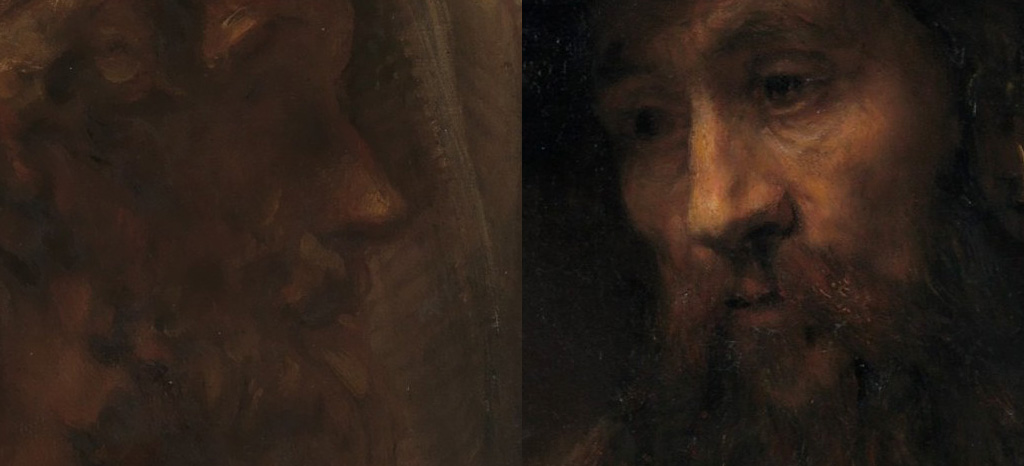 Later on, Vermeer would make extraordinary universes out of small rooms in the provincial town of Delft, but Rembrandt needed to leave his native Leiden for Amsterdam in order to drape his sitters in exotic costumes and enjoy the worldly benefits that his extraordinary talent afforded him.
Later on, Vermeer would make extraordinary universes out of small rooms in the provincial town of Delft, but Rembrandt needed to leave his native Leiden for Amsterdam in order to drape his sitters in exotic costumes and enjoy the worldly benefits that his extraordinary talent afforded him.
Slowly, from clean, crisp portraits and history paintings, atmosphere crept into his paintings. As he matured, the painterly qualities increased, making the sfumato and chiaroscuro all the more dramatic. Brush mark by brush mark, the tones constantly move from warm to cool and back again, and from lights to darks over charged surfaces where no two square centimetres are the same. Opaque impastos in ochres and flesh pinks are overlaid by greyish-green and umber translucent glazes, one over the other over the other to produce a dazzling weave that few have ever been able to match. Each mark demanded another in response, and Rembrandt always rose to the challenge. Never satisfied, he would work it and work it, and then work it some more.
He began to turn away from the worldly and looked inward. From the start, he had a certain insight, but through the loss of three of his four children and then his wife, bankruptcy, diminished fame and the loss of wealth, and equally through painting, he came to understand impermanence and the nature of God. His figures became enveloped in half-lit mists and shadows, with a beam of light cutting through to illuminate the sitter’s face to define features almost lost in the shadows.
Rembrandt may have met Spinoza who said that God and nature were one and the same, and Rembrandt showed it in his paintings. Not coincidentally, Spinoza was exiled from his Jewish community and Rembrandt would be shunned by art patrons who wanted these things separate and clearly defined.
It has been said that now that we know how certain painters “did” it, anyone can, as if great paintings were a secret formula that could be discovered and repeated. Whereas for Rembrandt, the secret was never to repeat himself. That was to be the undoing of his worldly success; that was to be the making of his genius.
Recently, it has been fashionable to pick on Vermeer, saying that anyone can be like him using a camera obscura, and now we have Damien Hirst piping in with, “Anyone can be like Rembrandt…It’s about looking. It can be learned. That’s the great thing about art. Anybody can do it if you just believe. With practice, you can make great paintings.” (http://www.theguardian.com/artanddesign/2009/nov/14/damien-hirst-interview)
For Hirst, it is a convenient counter to the criticism he has faced that anyone can put an organism in formaldehyde – anyone can make a Hirst, sure, but anyone can make a Rembrandt too. It takes the unique and extraordinary and makes it common and ordinary. Tearing someone else down in order to raise yourself. Limiting art and the world to your ego. A self-portrait is a selfie. A cow in formaldehyde is a masterpiece.
Likewise, what separates Shakespeare, Joyce, Billie Holiday, and Maria Callas from the rest of us is little more than a question of hours of practice. “How do you get to Carnegie Hall? Practice, practise, practice.” Anyone can do it.
Many highly talented Dutch artists came out of Rembrandt’s studio trained by the Master himself, they practiced, practiced, practiced, yet none could match him. Of all the hundreds of seventeenth century Dutch painters, only Vermeer, speculated to be the student of Rembrandt’s student Fabritius, could rise to his heights.
When Dutch wealth became entrenched and demanded art that was idealised and refined, Rembrandt stayed the course. He had the talent to paint in a way that would have solved his financial burdens and restored his battered reputation, but he stayed the course. It was his vision, it was his being, his essence, and he would stay the course. In that, he was as radical a painter as ever has been, and in the complexity of his work, as brilliant a painter as ever has been. Anyone can see that.
Look: that, too, is what makes a Rembrandt. Never satisfied, he worked it and worked it, and then worked it some more. Perseverance and toil, dedication, rigour, facing oneself, developing one’s art and vision in a world that will judge it harshly and unfairly and then say, “anyone can do it”.
Long before Rembrandt and Spinoza, Buddha also understood that God and nature were one and the same, and revealed the simple secrets of living. All it takes is practice, practice, practice. Sit still and slowly breathe in and out. Let go of your ego and see the world, God and nature as they are. Now anyone can do it.

